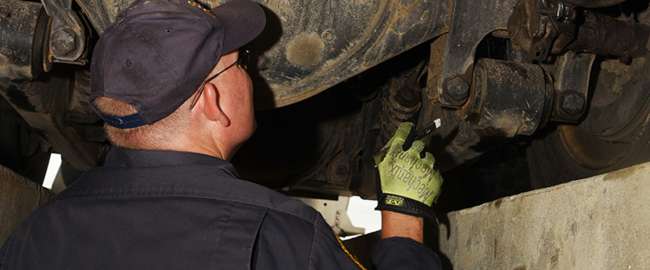Senior Reporter
Brake Safety Day Leaves 14% of Trucks Out of Service for Violations, CVSA Says

Roughly one out of every seven trucks and buses inspected during a one-day special brake safety law-enforcement effort in September was placed out of service for brake-related violations, according to the group that coordinated the inspections.
The inspections were part of Brake Safety Day on Sept. 7, during which highway patrol officers and inspectors throughout Canada and the United States inspected 7,698 commercial vehicles. And 14%, or 1,064, were put out of service due to brake problems.
By comparison, an unannounced Brake Safety Day on May 3 resulted in 12%, or 1,146, commercial vehicles being placed out of service for brake violations. During the May brake event, more than 9,500 commercial vehicles were inspected: 8,140 in the United States and 1,384 in Canada, the Commercial Vehicle Safety Alliance said.
14% of 7,698 CMV inspections conducted on Brake Safety Day were placed out of service for brake-related violations.https://t.co/PnLEATWQcg
— CVSA (@CVSA) November 7, 2017
CVSA represents North American commercial vehicle inspectors.
Those numbers compare with commercial motor vehicle inspectors and other officers placing 13.2% of trucks and buses examined out of service for brake violations during a weeklong law-enforcement operation last year, and with an out-of-service brake rate of 12.3% in 2015 and 16.2% in 2014 during Brake Safety Days.
A total of 40 jurisdictions participated in this year’s event — 31 American states and nine Canadian provinces.
This year, inspectors had a special focus in mind when they conducted inspections, with an eye on the future of automated vehicles, said Collin Mooney, CVSA’s executive director.
“For the first time, this year we focused on anti-lock braking systems,” Mooney told Transport Topics. “We were trying to get a handle on what sort of issues we have with ABS.”
During the Sept. 7 brake day, inspectors logged an 11% violation rate on air-braked power units that required ABS, 14% violation rate on trailers that required ABS, and a 5% violation rate on hydraulic-braked trucks that required ABS.
“Driver-assisted technologies are built off of an underlying functional ABS system. So as we start to go down this road introducing more automated braking systems, we wanted to see what the maintenance looked like. Maintenance is a challenge with 11% or 14% of the systems not working now,” Mooney said.
ABS violations were counted when the malfunction lamp did not work or the malfunction lamp stayed on, indicating a fault of some kind, CVSA said.
Besides brake-related violations, 22% of motor vehicles inspected in this year’s September event had other violations that caused them to be placed out of service.
“Brake-related violations are the largest percentage of all out-of-service violations cited during roadside inspections,” said CVSA’s president, Capt. Christopher Turner of the Kansas Highway Patrol. “Our goal is to reduce the number of crashes caused by faulty braking systems, by conducting roadside inspections, educating drivers, mechanics, owner-operators and others on the importance of proper brake inspection and maintenance.”
Since the launch of Brake Safety Day in 1998, law enforcement personnel have inspected more than 3.4 million brakes.
Inspection data from this year’s brake event also showed that 78% of the vehicles inspected did not have any out-of-service conditions.
CVSA said that properly functioning brake systems are crucial to safe commercial motor vehicle operations. Improperly installed or poorly maintained brake systems can reduce braking efficiency and increase the stopping distance of large trucks and buses, posing serious risks to driver and public safety. ABS, combined with the brake system, provides a platform for stability control and for other safety-enhancing systems to function.




